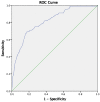Development of Prediction Model for 1-year Mortality after Hip Fracture Surgery
- PMID: 38825823
- PMCID: PMC11162873
- DOI: 10.5371/hp.2024.36.2.135
Development of Prediction Model for 1-year Mortality after Hip Fracture Surgery
Abstract
Purpose: Hip fractures are associated with increased mortality. The identification of risk factors of mortality could improve patient care. The aim of the study was to identify risk factors of mortality after surgery for a hip fracture and construct a mortality model.
Materials and methods: A cohort study was conducted on patients with hip fractures at two institutions. Five hundred and ninety-seven patients with hip fractures that were treated in the tertiary hospital, and another 147 patients that were treated in a secondary hospital. The perioperative data were collected from medical charts and interviews. Functional Assessment Measure score, Short Form-12 and mortality were recorded at 12 months. Patients and surgery variables that were associated with increased mortality were used to develop a mortality model.
Results: Mortality for the whole cohort was 19.4% at one year. From the variables tested only age >80 years, American Society of Anesthesiologists category, time to surgery (>48 hours), Charlson comorbidity index, sex, use of anti-coagulants, and body mass index <25 kg/m2 were associated with increased mortality and used to construct the mortality model. The area under the curve for the prediction model was 0.814. Functional outcome at one year was similar to preoperative status, even though their level of physical function dropped after the hip surgery and slowly recovered.
Conclusion: The mortality prediction model that was developed in this study calculates the risk of death at one year for patients with hip fractures, is simple, and could detect high risk patients that need special management.
Keywords: American Society of Anesthesiologists; Body mass index; Hip fractures; Mortality.
Conflict of interest statement
No potential conflict of interest relevant to this article was reported.
Figures
References
-
- Xu BY, Yan S, Low LL, Vasanwala FF, Low SG. Predictors of poor functional outcomes and mortality in patients with hip fracture: a systematic review. BMC Musculoskelet Disord. 2019;20:568. doi: 10.1186/s12891-019-2950-0. https://doi.org/10.1186/s12891-019-2950-0. - DOI - PMC - PubMed
-
- Veronese N, Maggi S. Epidemiology and social costs of hip fracture. Injury. 2018;49:1458–60. doi: 10.1016/j.injury.2018.04.015. https://doi.org/10.1016/j.injury.2018.04.015. - DOI - PubMed
-
- Wiles MD, Moran CG, Sahota O, Moppett IK. Nottingham Hip Fracture Score as a predictor of one year mortality in patients undergoing surgical repair of fractured neck of femur. Br J Anaesth. 2011;106:501–4. doi: 10.1093/bja/aeq405. https://doi.org/10.1093/bja/aeq405. - DOI - PubMed
-
- Charlson M, Szatrowski TP, Peterson J, Gold J. Validation of a combined comorbidity index. J Clin Epidemiol. 1994;47:1245–51. doi: 10.1016/0895-4356(94)90129-5. https://doi.org/10.1016/0895-4356(94)90129-5. - DOI - PubMed
-
- Mayhew D, Mendonca V, Murthy BVS. A review of ASA physical status - historical perspectives and modern developments. Anaesthesia. 2019;74:373–9. doi: 10.1111/anae.14569. https://doi.org/10.1111/anae.14569. - DOI - PubMed
LinkOut - more resources
Full Text Sources



